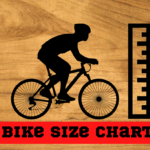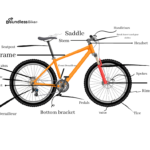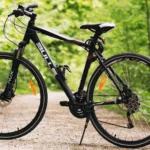When it comes to finding the right size for a bike, it can be tricky to figure out which size bike is best for you. If you’re looking for a 24 inch bike, you’ll want to know what size person is best suited for this type of bike. In this article, we’ll cover how to size a bike by rider height, what size 24 inch bike should you buy, the pros and cons of a 24 inch bike, 24 inch bike safety considerations, 24 inch bike tests, recommended bikes for different sizes, and accessories for 24 inch bikes. So if you’re wondering what size person is best suited for a 24 inch bike, read on!
24 inch bike for what size person?
In general, a 24-inch bike is suitable for children with a height of 4’8” to 5’3 or 5’4”. This size range is based on average height statistics, but it is important to note that every child is unique and may have different needs. In addition to the size of the bike, it’s also important to consider the child’s skill level and the type of riding they will be doing. Different bikes are designed for different types of riding such as BMX, mountain biking, road racing, etc. A bike shop can help you choose a bike that is appropriate for your child’s skill level and riding style. Check the chart below.
| Height (feet) | Age | Bike Size (inches) |
|---|---|---|
| 3’1″ – 3’7″ | 2-4 | 12-14 |
| 3’7″ – 4’0″ | 4-5 | 14-16 |
| 4’0″ – 4’4″ | 5-6 | 16-20 |
| 4’4″ – 4’8″ | 6-8 | 20-24 |
| 4’8″ – 5’4″ | 8-10 | 24-26 |
| 5’4″ – 5’6″ | 11+ | 26-28 |
What age is a 24 inch bike for?

Typically, a 24-inch bike frame size is suitable for kids between 8 to 10 years old or with a height of 4.8 to 5.4 inches. However, as every child is unique, it is recommended to have a professional fitting at a local bike shop to ensure that the frame size is appropriate for the child’s height and body proportions.
It’s important to choose a frame size that allows the child to easily reach the pedals, handlebars, and brake levers, and provides a comfortable, stable, and safe riding experience. A properly fitted bike will allow the child to easily balance and control the bike, and enjoy their cycling journey.
How to Size a Bike by Rider Height
When sizing a bike, it’s important to consider the rider’s height. The general rule of thumb is that a rider should be able to straddle the top tube of the bike with their feet flat on the ground. If the rider is too tall for the bike, they won’t be able to straddle the top tube and will be uncomfortable. Conversely, if the rider is too short for the bike, they won’t be able to reach the handlebars or pedals properly and will also be uncomfortable.
The best way to size a bike is to measure the rider’s inseam, which is the distance from the ground to the rider’s crotch. This will give you a good estimate of the rider’s height and will help you find the right size bike. Generally, a 24 inch bike is best suited for riders with an inseam of at least 18 inches. However, if you’re looking for a more comfortable ride, you may want to go up to a 26 inch bike.
24 Inch Bike Safety Considerations
When it comes to a 24 inch bike, it’s important to consider safety as well. For younger riders, it’s important to make sure the bike fits properly and that the rider is comfortable on the bike. Additionally, make sure the bike has working brakes and that the tires are in good condition. Finally, it’s important to make sure the rider has the proper safety gear, such as a helmet and knee pads.
24 Inch Bike Tests
Before buying a 24 inch bike, it’s important to make sure it’s the right size for the rider. The best way to do this is to do a test ride. When testing a 24 inch bike, make sure the rider can reach the handlebars and pedals comfortably and that they can straddle the top tube with their feet flat on the ground. Additionally, make sure the bike is comfortable to ride and that the brakes work properly.
Accessories for 24 Inch Bikes
- Helmet & Knee pad: A helmet is the most important safety accessory for any cyclist. Look for a helmet that fits well and meets safety standards.
- Lights: Lights can improve visibility and ensure safety during rides in low-light conditions.
- Bell: A bell is a simple accessory that allows the rider to signal to others on the road.
- Reflectors: Reflectors can help improve visibility and increase safety when riding in low-light conditions.
- Kickstand: A kickstand makes it easier to park the bike and keeps it upright when not in use.
- Water bottle holder: A water bottle holder can help keep the rider hydrated during long rides.
- Basket or panniers: A basket or panniers can be useful for carrying items during rides.
- Tire pump: A tire pump is a handy accessory to have on hand in case of a flat tire.
- Chain guard: A chain guard helps keep clothing and body parts from getting caught in the chain.
- Training wheels: If your child is just starting to learn to ride, training wheels can provide extra stability.
These accessories can enhance the ride experience and ensure a safe and comfortable ride for the rider.
Faq
A: A 24-inch bike is typically designed for children with a height range of 4’8″ to 5’4″.
A: While it is possible for an adult to use a 24-inch bike, it may not be comfortable as the bike is designed for children with a smaller stature.
A: Yes, most bikes come with adjustable seats and handlebars to ensure a comfortable ride for the rider.
A: When purchasing a 24-inch bike for your child, look for a bike that fits their height and leg length, has adjustable seat and handlebars, and is made with high-quality materials to ensure durability and safety.
Tips considering 24 inch bike
- Fit: Ensure that the bike fits your child’s height and leg length. A professional fitting or consulting the manufacturer’s size chart is recommended.
- Adjustability: Look for a bike with adjustable seat and handlebars, so that your child can grow with the bike.
- Quality: Choose a bike made with high-quality materials to ensure durability and safety.
- Safety features: Look for features such as hand brakes, reflectors, and a kickstand to ensure your child’s safety while riding the bike.
- Purpose: Consider the purpose of the bike, such as recreational riding, racing, or off-road riding, and choose a bike that suits those needs.
- Budget: Consider your budget and choose a bike that fits both your needs and your budget.
- Test ride: Encourage your child to take the bike for a test ride to ensure that it’s comfortable and the right fit.
Conclusion
When it comes to finding the right size bike, it’s important to take into account the size of the rider. When choosing a 24 inch bike, make sure the rider can reach the handlebars and pedals comfortably and that they can straddle the top tube with their feet flat on the ground. Additionally, make sure the bike is comfortable to ride and has working brakes. Finally, make sure the rider has the necessary safety gear and that you have the right accessories for the bike.






